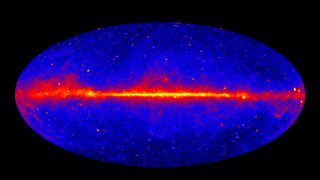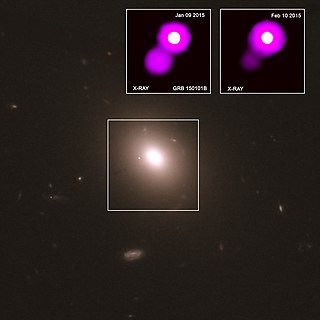
In gamma-ray astronomy, gamma-ray bursts (GRBs) are immensely energetic events occurring in distant galaxies which represent the brightest and "most powerful class of explosion in the universe." These extreme electromagnetic events are second only to the Big Bang as the most energetic and luminous phenomenon ever known. Gamma-ray bursts can last from a few milliseconds to several hours. After the initial flash of gamma rays, a longer-lived § afterglow is emitted, usually in the longer wavelengths of X-ray, ultraviolet, optical, infrared, microwave or radio frequencies.

The Fermi Gamma-ray Space Telescope, formerly called the Gamma-ray Large Area Space Telescope (GLAST), is a space observatory being used to perform gamma-ray astronomy observations from low Earth orbit. Its main instrument is the Large Area Telescope (LAT), with which astronomers mostly intend to perform an all-sky survey studying astrophysical and cosmological phenomena such as active galactic nuclei, pulsars, other high-energy sources and dark matter. Another instrument aboard Fermi, the Gamma-ray Burst Monitor, is being used to study gamma-ray bursts and solar flares.

Neil Gehrels Swift Observatory, previously called the Swift Gamma-Ray Burst Explorer, is a NASA three-telescope space observatory for studying gamma-ray bursts (GRBs) and monitoring the afterglow in X-ray, and UV/visible light at the location of a burst. It was launched on 20 November 2004, aboard a Delta II launch vehicle. Headed by principal investigator Neil Gehrels until his death in February 2017, the mission was developed in a joint partnership between Goddard Space Flight Center (GSFC) and an international consortium from the United States, United Kingdom, and Italy. The mission is operated by Pennsylvania State University as part of NASA's Medium Explorer program (MIDEX).

GRB 970228 was the first gamma-ray burst (GRB) for which an afterglow was observed. It was detected on 28 February 1997 at 02:58 UTC. Since 1993, physicists had predicted GRBs to be followed by a lower-energy afterglow, but until this event, GRBs had only been observed in highly luminous bursts of high-energy gamma rays ; this resulted in large positional uncertainties which left their nature very unclear.

GRB 060218 was a gamma-ray burst with unusual characteristics never seen before. This GRB was detected by the Swift satellite on February 18, 2006, and its name is derived from the date. It was located in the constellation Aries.

Cornelis A. "Neil" Gehrels was an American astrophysicist specializing in the field of gamma-ray astronomy. He was Chief of the Astroparticle Physics Laboratory at NASA's Goddard Space Flight Center (GSFC) from 1995 until his death, and was best known for his work developing the field from early balloon instruments to today's space observatories such as the NASA Swift mission, for which he was the principal investigator. He was leading the WFIRST wide-field infrared telescope forward toward a launch in the mid-2020s. He was a member of the National Academy of Sciences and the American Academy of Arts and Sciences.

Gamma-ray burst progenitors are the types of celestial objects that can emit gamma-ray bursts (GRBs). GRBs show an extraordinary degree of diversity. They can last anywhere from a fraction of a second to many minutes. Bursts could have a single profile or oscillate wildly up and down in intensity, and their spectra are highly variable unlike other objects in space. The near complete lack of observational constraint led to a profusion of theories, including evaporating black holes, magnetic flares on white dwarfs, accretion of matter onto neutron stars, antimatter accretion, supernovae, hypernovae, and rapid extraction of rotational energy from supermassive black holes, among others.

GRB 080319B was a gamma-ray burst (GRB) detected by the Swift satellite at 06:12 UTC on March 19, 2008. The burst set a new record for the farthest object that was observable with the naked eye: it had a peak visual apparent magnitude of 5.7 and remained visible to human eyes for approximately 30 seconds. The magnitude was brighter than 9.0 for approximately 60 seconds. If viewed from 1 AU away, it would have had a peak apparent magnitude of −67.57. It had an absolute magnitude of −38.6, beaten by GRB 220101A with −39.4 in 2023.
The history of gamma-ray began with the serendipitous detection of a gamma-ray burst (GRB) on July 2, 1967, by the U.S. Vela satellites. After these satellites detected fifteen other GRBs, Ray Klebesadel of the Los Alamos National Laboratory published the first paper on the subject, Observations of Gamma-Ray Bursts of Cosmic Origin. As more and more research was done on these mysterious events, hundreds of models were developed in an attempt to explain their origins.

GRB 090423 was a gamma-ray burst (GRB) detected by the Swift Gamma-Ray Burst Mission on April 23, 2009, at 07:55:19 UTC whose afterglow was detected in the infrared and enabled astronomers to determine that its redshift is z = 8.2, making it one of the most distant objects detected at that time with a spectroscopic redshift.

Gamma-ray astronomy is a subfield of astronomy where scientists observe and study celestial objects and phenomena in outer space which emit cosmic electromagnetic radiation in the form of gamma rays, i.e. photons with the highest energies at the very shortest wavelengths. Radiation below 100 keV is classified as X-rays and is the subject of X-ray astronomy.

GRB 991216, nicknamed the Beethoven Burst by Dr. Brad Schaefer of Yale University, was a gamma-ray burst observed on December 16, 1999, coinciding with the 229th anniversary of Ludwig van Beethoven's birth. A gamma-ray burst is a highly luminous flash associated with an explosion in a distant galaxy and producing gamma rays, the most energetic form of electromagnetic radiation, and often followed by a longer-lived "afterglow" emitted at longer wavelengths.

GRB 101225A, also known as the "Christmas burst", was a cosmic explosion first detected by NASA's Swift observatory on Christmas Day 2010. The gamma-ray emission lasted at least 28 minutes, which is unusually long. Follow-up observations of the burst's afterglow by the Hubble Space Telescope and ground-based observatories were unable to determine the object's distance using spectroscopic methods.

A kilonova is a transient astronomical event that occurs in a compact binary system when two neutron stars or a neutron star and a black hole merge. These mergers are thought to produce gamma-ray bursts and emit bright electromagnetic radiation, called "kilonovae", due to the radioactive decay of heavy r-process nuclei that are produced and ejected fairly isotropically during the merger process. The measured high sphericity of the kilonova AT2017gfo at early epochs was deduced from the blackbody nature of its spectrum.

A hypernova is a very energetic supernova which is believed to result from an extreme core collapse scenario. In this case, a massive star collapses to form a rotating black hole emitting twin astrophysical jets and surrounded by an accretion disk. It is a type of stellar explosion that ejects material with an unusually high kinetic energy, an order of magnitude higher than most supernovae, with a luminosity at least 10 times greater. Hypernovae release such intense gamma rays that they often appear similar to a type Ic supernova, but with unusually broad spectral lines indicating an extremely high expansion velocity. Hypernovae are one of the mechanisms for producing long gamma ray bursts (GRBs), which range from 2 seconds to over a minute in duration. They have also been referred to as superluminous supernovae, though that classification also includes other types of extremely luminous stellar explosions that have different origins.

SN 2018cow was a very powerful astronomical explosion, 10–100 times brighter than a normal supernova, spatially coincident with galaxy CGCG 137-068, approximately 200 million ly (60 million pc) distant in the Hercules constellation. It was discovered on 16 June 2018 by the ATLAS-HKO telescope, and had generated significant interest among astronomers throughout the world. Later, on 10 July 2018, and after AT 2018cow had significantly faded, astronomers, based on follow-up studies with the Nordic Optical Telescope (NOT), formally described AT 2018cow as SN 2018cow, a type Ib supernova, showing an "unprecedented spectrum for a supernova of this class"; although others, mostly at first but also more recently, have referred to it as a type Ic-BL supernova. An explanation to help better understand the unique features of AT 2018cow has been presented. AT2018cow is one of the few reported Fast Blue Optical Transients (FBOTs) observed in the Universe. In May 2020, however, a much more powerful FBOT than AT 2018cow was reportedly observed.

GRB 150101B is a short gamma-ray burst that was detected on 1 January 2015 at 15:23 UT by the Burst Alert Telescope (BAT) on board the Swift Observatory Satellite, and at 15:23:35 UT by the Gamma-ray Burst Monitor (GBM) on board the Fermi Gamma-ray Space Telescope. The GRB was determined to be 1.7 billion light-years (0.52 Gpc) from Earth near the host galaxy 2MASX J12320498-1056010 in the constellation Virgo. The characteristics of GRB 150101B are remarkably similar to those of historic event GW170817, known to be a merger of two neutron stars.

GRB 221009A was an extraordinarily bright and very energetic gamma-ray burst (GRB) jointly discovered by the Neil Gehrels Swift Observatory and the Fermi Gamma-ray Space Telescope on October 9, 2022. The gamma-ray burst was ten minutes long, but was detectable for more than ten hours following initial detection. Despite being around 2.4 billion light-years away, it was powerful enough to affect Earth's atmosphere, having the strongest effect ever recorded by a gamma-ray burst on the planet. The peak luminosity of GRB 221009A was measured by Konus-Wind to be ~ 2.1 × 1047 W and by Fermi Gamma-ray Burst Monitor to be ~ 1.0 × 1047 W over its 1.024s interval. A burst as energetic and as close to Earth as 221009A is thought to be a once-in-10,000-year event. It was the brightest and most energetic gamma-ray burst ever recorded, with some dubbing it the BOAT, or Brightest Of All Time.

AT 2021lwx (also known as ZTF20abrbeie or "Scary Barbie") is the most energetic non-quasar optical transient astronomical event ever observed, with a peak luminosity of 7 × 1045 erg per second (erg s−1) and a total radiated energy between 9.7 × 1052 erg to 1.5 × 1053 erg over three years. Despite being lauded as the largest explosion ever, GRB 221009A was both more energetic and brighter. It was first identified in imagery obtained on 13 April 2021 by the Zwicky Transient Facility (ZTF) astronomical survey and is believed to be due to the accretion of matter into a super massive black hole (SMBH) heavier than one hundred million solar masses (M☉). It has a redshift of z = 0.9945, which would place it at a distance of about eight billion light-years from earth, and is located in the constellation Vulpecula. No host galaxy has been detected.


















